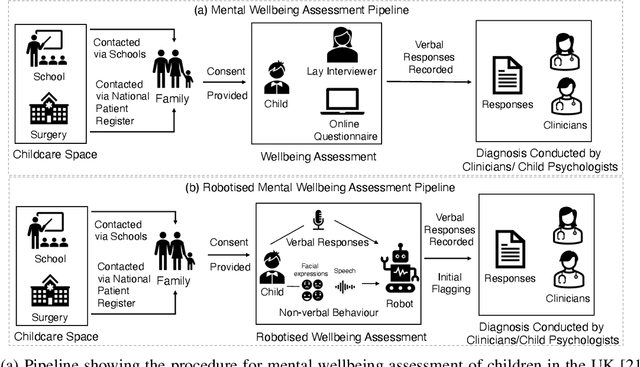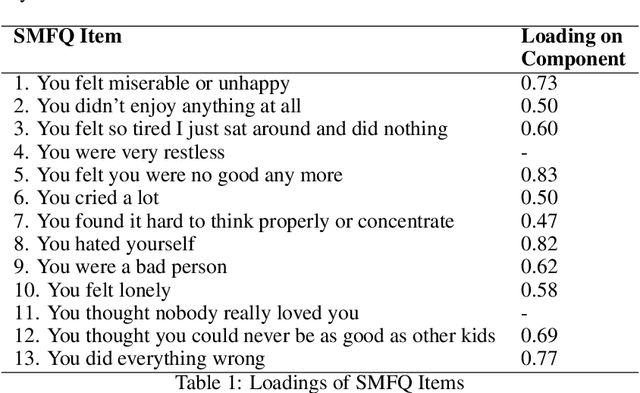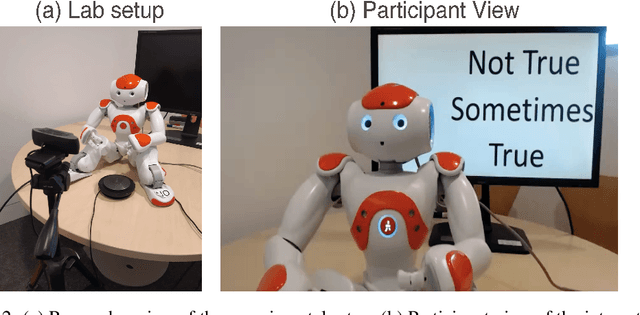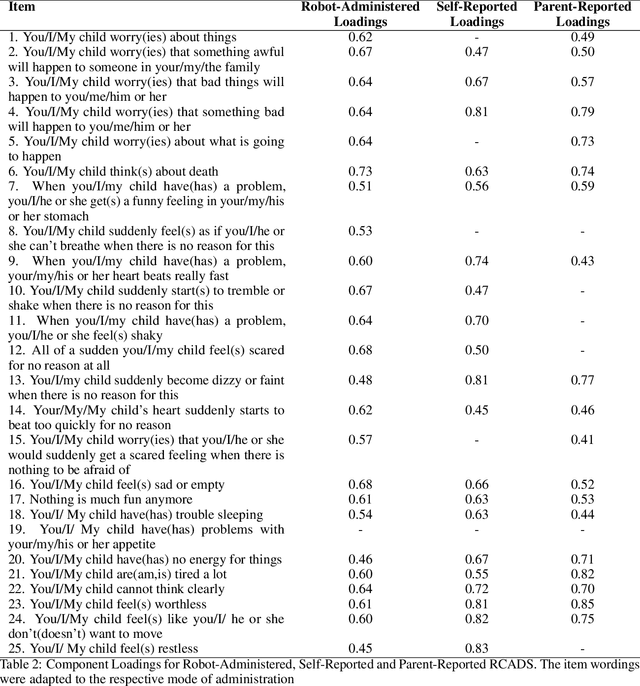Guy Laban
Critical Insights about Robots for Mental Wellbeing
Jun 16, 2025Abstract:Social robots are increasingly being explored as tools to support emotional wellbeing, particularly in non-clinical settings. Drawing on a range of empirical studies and practical deployments, this paper outlines six key insights that highlight both the opportunities and challenges in using robots to promote mental wellbeing. These include (1) the lack of a single, objective measure of wellbeing, (2) the fact that robots don't need to act as companions to be effective, (3) the growing potential of virtual interactions, (4) the importance of involving clinicians in the design process, (5) the difference between one-off and long-term interactions, and (6) the idea that adaptation and personalization are not always necessary for positive outcomes. Rather than positioning robots as replacements for human therapists, we argue that they are best understood as supportive tools that must be designed with care, grounded in evidence, and shaped by ethical and psychological considerations. Our aim is to inform future research and guide responsible, effective use of robots in mental health and wellbeing contexts.
Comparing Self-Disclosure Themes and Semantics to a Human, a Robot, and a Disembodied Agent
Apr 08, 2025Abstract:As social robots and other artificial agents become more conversationally capable, it is important to understand whether the content and meaning of self-disclosure towards these agents changes depending on the agent's embodiment. In this study, we analysed conversational data from three controlled experiments in which participants self-disclosed to a human, a humanoid social robot, and a disembodied conversational agent. Using sentence embeddings and clustering, we identified themes in participants' disclosures, which were then labelled and explained by a large language model. We subsequently assessed whether these themes and the underlying semantic structure of the disclosures varied by agent embodiment. Our findings reveal strong consistency: thematic distributions did not significantly differ across embodiments, and semantic similarity analyses showed that disclosures were expressed in highly comparable ways. These results suggest that while embodiment may influence human behaviour in human-robot and human-agent interactions, people tend to maintain a consistent thematic focus and semantic structure in their disclosures, whether speaking to humans or artificial interlocutors.
Robot-Led Vision Language Model Wellbeing Assessment of Children
Apr 03, 2025Abstract:This study presents a novel robot-led approach to assessing children's mental wellbeing using a Vision Language Model (VLM). Inspired by the Child Apperception Test (CAT), the social robot NAO presented children with pictorial stimuli to elicit their verbal narratives of the images, which were then evaluated by a VLM in accordance with CAT assessment guidelines. The VLM's assessments were systematically compared to those provided by a trained psychologist. The results reveal that while the VLM demonstrates moderate reliability in identifying cases with no wellbeing concerns, its ability to accurately classify assessments with clinical concern remains limited. Moreover, although the model's performance was generally consistent when prompted with varying demographic factors such as age and gender, a significantly higher false positive rate was observed for girls, indicating potential sensitivity to gender attribute. These findings highlight both the promise and the challenges of integrating VLMs into robot-led assessments of children's wellbeing.
Beyond Vision: How Large Language Models Interpret Facial Expressions from Valence-Arousal Values
Feb 08, 2025Abstract:Large Language Models primarily operate through text-based inputs and outputs, yet human emotion is communicated through both verbal and non-verbal cues, including facial expressions. While Vision-Language Models analyze facial expressions from images, they are resource-intensive and may depend more on linguistic priors than visual understanding. To address this, this study investigates whether LLMs can infer affective meaning from dimensions of facial expressions-Valence and Arousal values, structured numerical representations, rather than using raw visual input. VA values were extracted using Facechannel from images of facial expressions and provided to LLMs in two tasks: (1) categorizing facial expressions into basic (on the IIMI dataset) and complex emotions (on the Emotic dataset) and (2) generating semantic descriptions of facial expressions (on the Emotic dataset). Results from the categorization task indicate that LLMs struggle to classify VA values into discrete emotion categories, particularly for emotions beyond basic polarities (e.g., happiness, sadness). However, in the semantic description task, LLMs produced textual descriptions that align closely with human-generated interpretations, demonstrating a stronger capacity for free text affective inference of facial expressions.
Past, Present, and Future: A Survey of The Evolution of Affective Robotics For Well-being
Jul 03, 2024Abstract:Recent research in affective robots has recognized their potential in supporting human well-being. Due to rapidly developing affective and artificial intelligence technologies, this field of research has undergone explosive expansion and advancement in recent years. In order to develop a deeper understanding of recent advancements, we present a systematic review of the past 10 years of research in affective robotics for wellbeing. In this review, we identify the domains of well-being that have been studied, the methods used to investigate affective robots for well-being, and how these have evolved over time. We also examine the evolution of the multifaceted research topic from three lenses: technical, design, and ethical. Finally, we discuss future opportunities for research based on the gaps we have identified in our review -- proposing pathways to take affective robotics from the past and present to the future. The results of our review are of interest to human-robot interaction and affective computing researchers, as well as clinicians and well-being professionals who may wish to examine and incorporate affective robotics in their practices.
A Longitudinal Study of Child Wellbeing Assessment via Online Interactions with a Social Robots
Apr 16, 2024



Abstract:Socially Assistive Robots are studied in different Child-Robot Interaction settings. However, logistical constraints limit accessibility, particularly affecting timely support for mental wellbeing. In this work, we have investigated whether online interactions with a robot can be used for the assessment of mental wellbeing in children. The children (N=40, 20 girls and 20 boys; 8-13 years) interacted with the Nao robot (30-45 mins) over three sessions, at least a week apart. Audio-visual recordings were collected throughout the sessions that concluded with the children answering user perception questionnaires pertaining to their anxiety towards the robot, and the robot's abilities. We divided the participants into three wellbeing clusters (low, med and high tertiles) using their responses to the Short Moods and Feelings Questionnaire (SMFQ) and further analysed how their wellbeing and their perceptions of the robot changed over the wellbeing tertiles, across sessions and across participants' gender. Our primary findings suggest that (I) online mediated-interactions with robots can be effective in assessing children's mental wellbeing over time, and (II) children's overall perception of the robot either improved or remained consistent across time. Supplementary exploratory analyses have also revealed that gender affected the children's wellbeing assessments as well as their perceptions of the robot.
Robotising Psychometrics: Validating Wellbeing Assessment Tools in Child-Robot Interactions
Feb 28, 2024Abstract:The interdisciplinary nature of Child-Robot Interaction (CRI) fosters incorporating measures and methodologies from many established domains. However, when employing CRI approaches to sensitive avenues of health and wellbeing, caution is critical in adapting metrics to retain their safety standards and ensure accurate utilisation. In this work, we conducted a secondary analysis to previous empirical work, investigating the reliability and construct validity of established psychological questionnaires such as the Short Moods and Feelings Questionnaire (SMFQ) and three subscales (generalised anxiety, panic and low mood) of the Revised Child Anxiety and Depression Scale (RCADS) within a CRI setting for the assessment of mental wellbeing. Through confirmatory principal component analysis, we have observed that these measures are reliable and valid in the context of CRI. Furthermore, our analysis revealed that scales communicated by a robot demonstrated a better fit than when self-reported, underscoring the efficiency and effectiveness of robot-mediated psychological assessments in these settings. Nevertheless, we have also observed variations in item contributions to the main factor, suggesting potential areas of examination and revision (e.g., relating to physiological changes, inactivity and cognitive demands) when used in CRI. Findings from this work highlight the importance of verifying the reliability and validity of standardised metrics and assessment tools when employed in CRI settings, thus, aiming to avoid any misinterpretations and misrepresentations.
 Add to Chrome
Add to Chrome Add to Firefox
Add to Firefox Add to Edge
Add to Edge